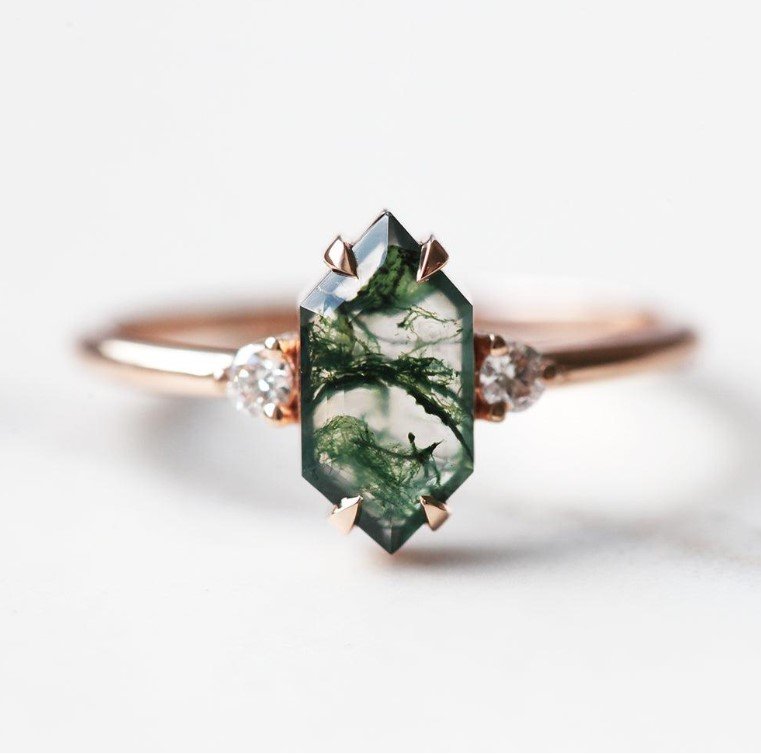The engagement ring is more than a piece of jewelry. It’s a symbol that carries personal meaning, shared history, and the promise of a future together. While styles and traditions have shifted over time, the sentiment behind it remains timeless: it marks a commitment.
A Brief History of the Engagement Ring and Its Settings
The tradition of giving these rings can be traced back to ancient Rome, where they symbolized a formal agreement to wed. The idea of using a precious stone came much later, most notably with the Archduke Maximilian of Austria in the 15th century, who gave a diamond ring to Mary of Burgundy. Over time, a wide variety of styles have developed, ranging from simple bands to intricate settings and designs.
Popular styles like solitaire, halo, and three stone settings emerged, each with unique characteristics that influence the piece’s look and durability. The solitaire setting, featuring a single center diamond, remains the most popular style due to its timeless elegance and ability to showcase the stone’s clarity and cut.
Types of Ring Setting
The setting not only secures the stone but also defines the overall style and personality of the piece. With so many settings to choose from, it’s worth exploring which design best fits your partner’s taste and lifestyle.
Solitaire settings are a timeless favorite, featuring a single, stunning set on a simple band. If you’re looking for extra sparkle, halo settings surround the center with a circle of pavé-set diamonds, amplifying the fire and making the center stone appear larger.
Three-stone settings, on the other hand, feature a center diamond flanked by two smaller stones, symbolizing your past, present, and future together. This meaningful style offers a balanced look and plenty of brilliance.
If you’re searching for something truly unique, exquisite handmade settings allow you to customize every detail, from the metal to the arrangement of stones.
Moss Agate: Nature’s Impression in Stone
Moss agate has become a popular alternative for those looking for a stone with an organic, earthy feel. Known for its unique, plant-like inclusions that resemble moss or branches, no two stones are exactly alike. This makes each moss agate ring truly one of a kind. The stone tends to have a soft, milky background with green or dark inclusions that create a natural, earthy texture.
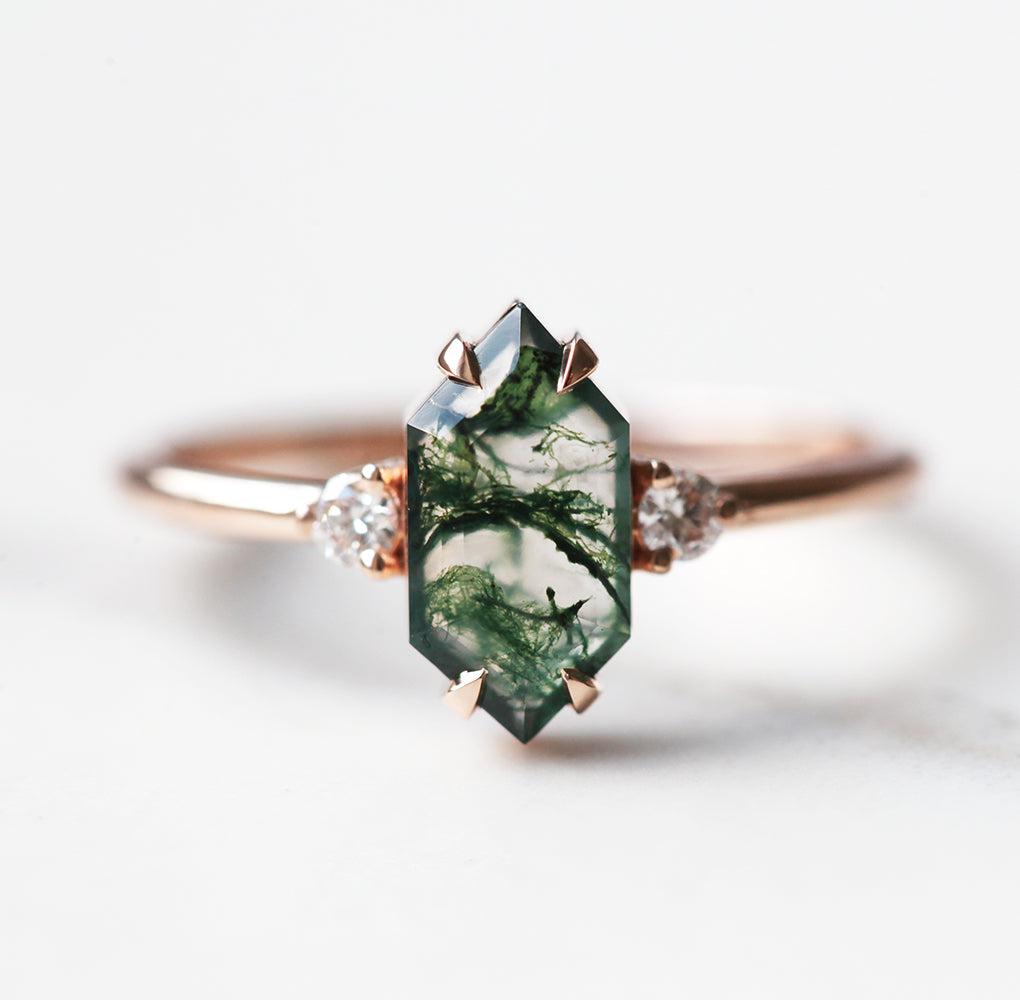
Source: Capucinne.com
Moss agate appeals to those who want a deeper connection to nature, symbolism, and individuality. It’s often chosen by couples who appreciate subtlety over sparkle and who see beauty in imperfection.
Alexandrite: A Stone That Changes With You
Alexandrite is one of the rarest gemstones available for rings, and it’s known for its remarkable color-changing properties. In natural light, it often appears greenish or bluish, but under incandescent light, it shifts to a reddish or purplish hue. This dramatic change adds a layer of mystery and intrigue, which is why many people find it symbolic of adaptability, growth, and duality.
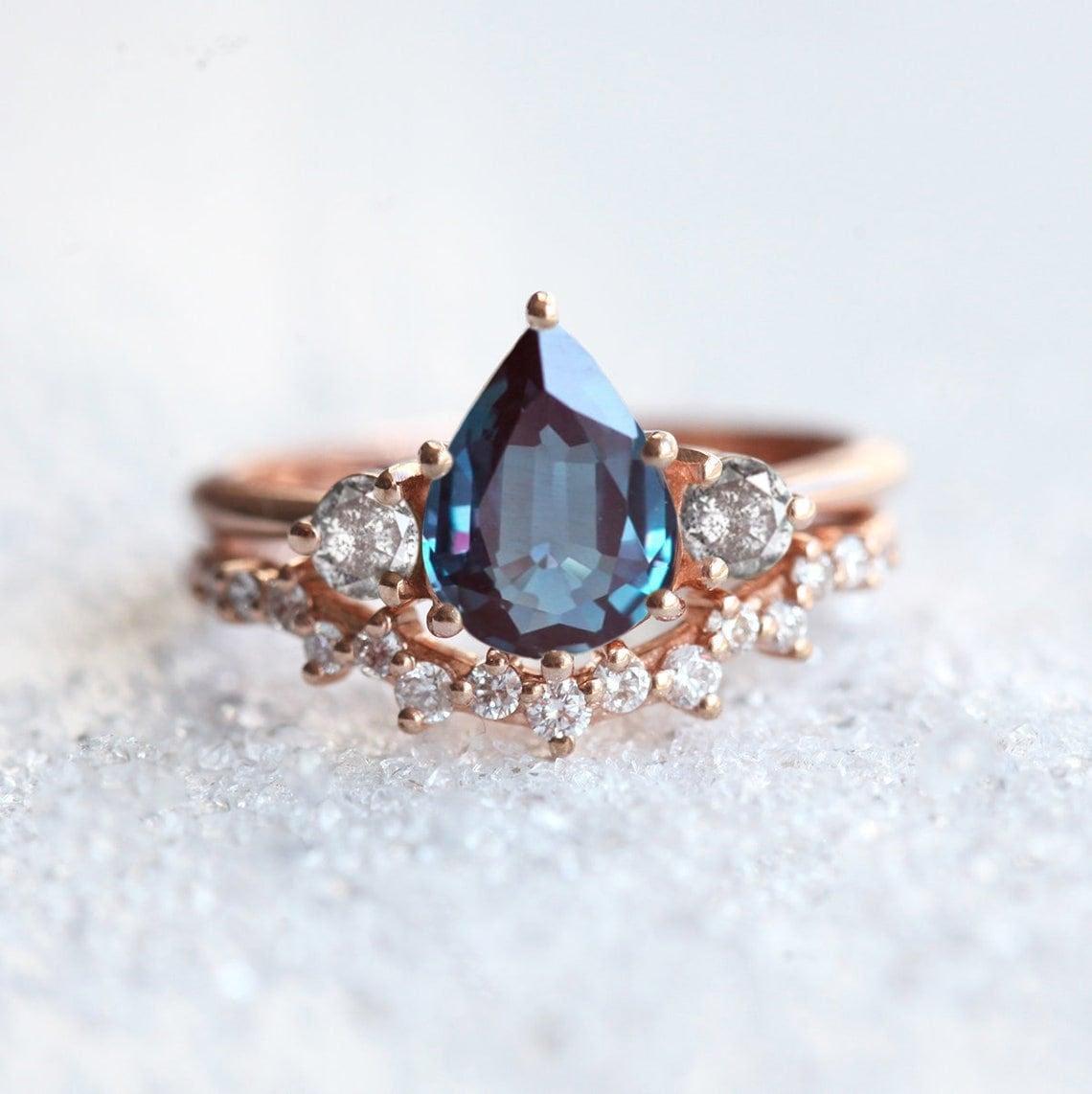
Source: Capucinne.com
Alexandrite is a meaningful choice for those who want their ring to reflect the complexity of their relationship and personality. Its rarity also adds to its appeal for couples seeking something truly different.
Sapphire: Classic, But Far From Ordinary
Sapphire is one of the most versatile and durable stones, making it a practical yet elegant choice. While traditionally associated with deep royal blue, sapphires come in a wide range of colors, green, yellow, peach, teal, and even white.
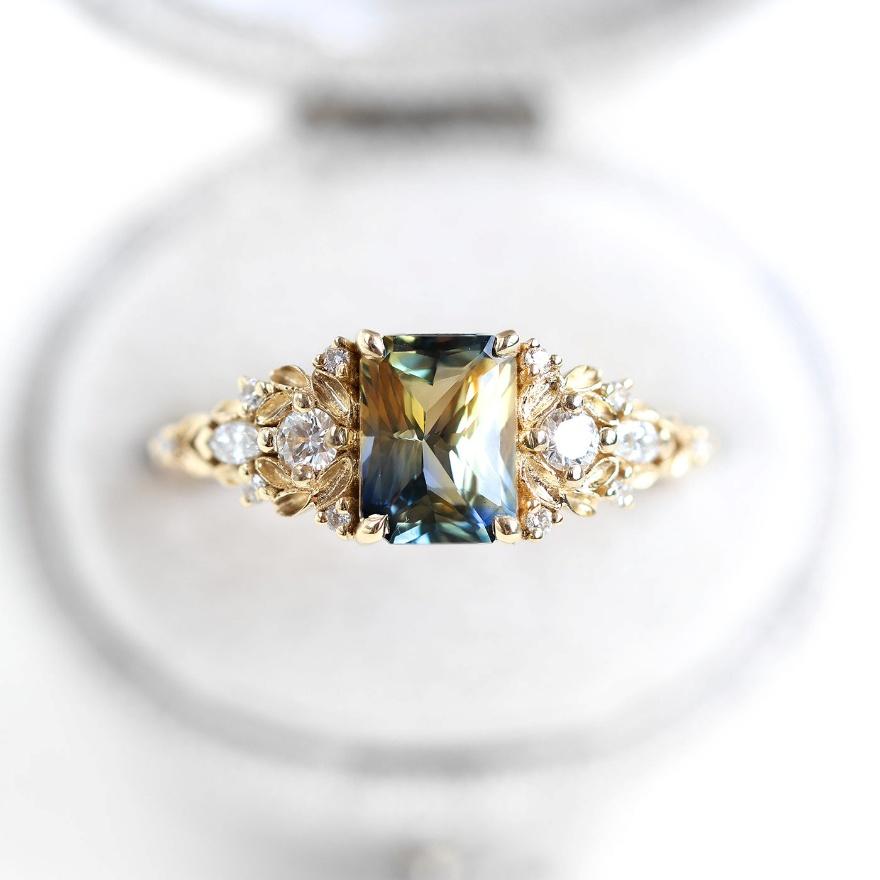
Source: Capucinne.com
The durability of sapphire makes it ideal for daily wear, while its range of colors allows couples to find a shade that fits their style. It also carries historical significance and has long been associated with wisdom and loyalty. Whether chosen for its symbolism or simply for its beauty, sapphire continues to be a favorite for couples who want something timeless but not too traditional.
Diamond Quality and Certification
The 4Cs, cut, color, clarity, and carat, determine a diamond’s beauty and value. Cut affects sparkle most, color ranges from colorless to faint tint, clarity refers to inclusions, and carat measures size. Certified diamonds from GIA or IGI ensure quality.
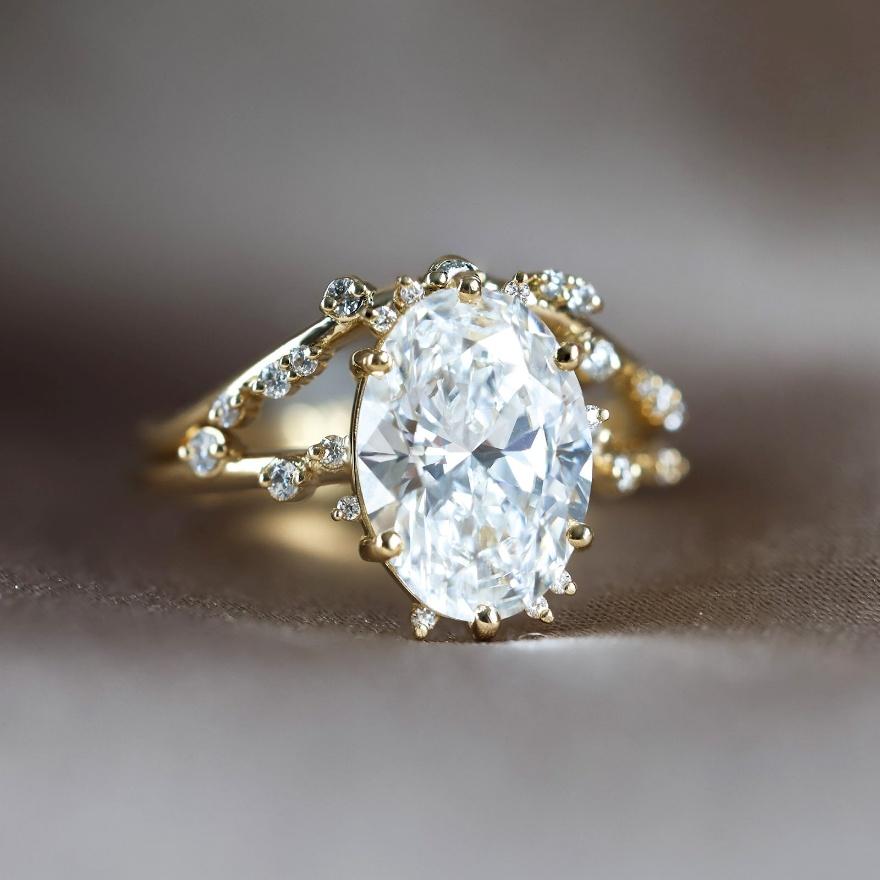
Source: Capucinne.com
Lab-grown diamonds offer the same qualities as natural ones but are often cheaper and eco-friendly. Settings like halo and three stone enhance appearance, while solitaire highlights the diamond itself. Use clear filters to find your style, and forget the “three months’ salary” rule; choose what fits your values and love story.
How to Choose a Ring That Feels Right
Use this guide to choose an engagement ring for helpful tips and information that will make your decision easier. There’s no formula for picking the “perfect” piece. The best place to start is by considering what matters to you and your partner. Here are a few things to think about:
1. Stone Type
While diamonds remain popular, colored gemstones offer a vibrant alternative. Sapphires, for example, come in many shades, including blue, peach, and green. Moonstones have a soft glow, while emeralds offer a rich, natural green. Each stone has its meaning, which can add an extra layer of symbolism.
2. Shape and Cut
The cut affects how the stone reflects light. Round cuts are classic, but many modern rings feature oval, pear, marquise, or cushion shapes. Each has its personality. Oval and pear-shaped stones, for instance, create an elongating effect on the finger and often feel more delicate or organic.
3. Ring Setting Style
A solitaire setting keeps it simple with a single stone, while halo settings surround the center stone with smaller diamonds for added brilliance. Bezel settings offer a more modern, protective design, wrapping the stone in metal. The three-stone setting features a center stone flanked by two smaller stones, symbolizing the past, present, and future. The setting changes the overall look and function, so it’s important to consider both style and practicality.
4. Metal
Gold, white gold, platinum, and rose gold are among the most popular choices. Each has a different tone and durability. The metal you choose should complement both the stone and your partner’s skin tone or personal preference.
Capucinne and the Art of Custom Rings
Capucinne is one of the names that often comes up in conversations around custom engagement rings. Based in Europe, the brand is known for its fine craftsmanship, organic designs, and focus on personalized jewelry. Each piece is made to order, which means the client can select shape, price, and setting style, and even request custom engravings. Capucinne works with a wide range of gemstones, from traditional diamonds to sapphires, moonstones, moss agates, and other alternative options. Sustainability is also part of their process, with ethically sourced materials and a mindful approach to production. Rather than following mainstream designs, the team puts care into every detail, aiming to create rings that feel timeless and deeply personal. To ensure a tailored and stress-free experience, clients can schedule an appointment with a Capucinne expert to discuss custom options and receive personalized guidance.
How to Choose a Ring That Feels Right
Use this guide to choose an engagement ring for helpful tips and information that will make your decision easier. There’s no formula for picking the “perfect” piece. The best place to start is by considering what matters to you and your partner. Here are a few things to think about:
1. Stone Type
While diamonds remain popular, colored gemstones offer a vibrant alternative. Sapphires, for example, come in many shades, including blue, peach, and green. Moonstones have a soft glow, while emeralds offer a rich, natural green. Each stone has its meaning, which can add an extra layer of symbolism.
2. Shape and Cut
The cut affects how the stone reflects light. Round cuts are classic, but many modern rings feature oval, pear, marquise, or cushion shapes. Each has its personality. Oval and pear-shaped stones, for instance, create an elongating effect on the finger and often feel more delicate or organic.
3. Ring Setting Style
A solitaire setting keeps it simple with a single stone, while halo settings surround the center stone with smaller diamonds for added brilliance. Bezel settings offer a more modern, protective design, wrapping the stone in metal. The three-stone setting features a center stone flanked by two smaller stones, symbolizing the past, present, and future. The setting changes the overall look and function, so it’s important to consider both style and practicality.
4. Metal
Gold, white gold, platinum, and rose gold are among the most popular choices. Each has a different tone and durability. The metal you choose should complement both the stone and your partner’s skin tone or personal preference.
Ethical Considerations
Sustainability and ethics have become important factors for many buyers. It’s no longer enough for a ring to look beautiful; people want to know it was made responsibly. This includes everything from how the metal was mined to where the gemstones were sourced. Conflict-free diamonds and recycled metals are now more widely available. Transparent practices and certifications like the Kimberley Process also help consumers make informed decisions.
Custom jewelers who create made-to-order rings often have more control over sourcing, which allows them to choose partners that meet ethical standards. This has made small and independent designers more appealing than ever.
Clear Filters
When shopping, using clear filters can help narrow down options efficiently. Filtering by ring setting, metal type, stone shape, and clarity allows you to focus on styles that match your preferences. Popular styles to consider include solitaire, halo, and three-stone settings, each offering different details and levels of brilliance.
The Difference Makes the Ring Special
Understanding the difference between settings, stone types, and cuts is essential to selecting a ring that truly reflects your story. Pairing the right diamond or gemstone with the perfect setting is crucial for creating a cohesive and personalized piece. The right combination enhances the diamond or gemstone’s brilliance and durability while aligning with your style and lifestyle. The process is only complete when the chosen setting and stone come together to form a finished, meaningful piece.
For couples exploring this journey, it’s worth slowing down and enjoying the process. Look beyond trends. Think about what feels true to you. And when you finally find the right one, it won’t just be a ring. It’ll be part of your story.

